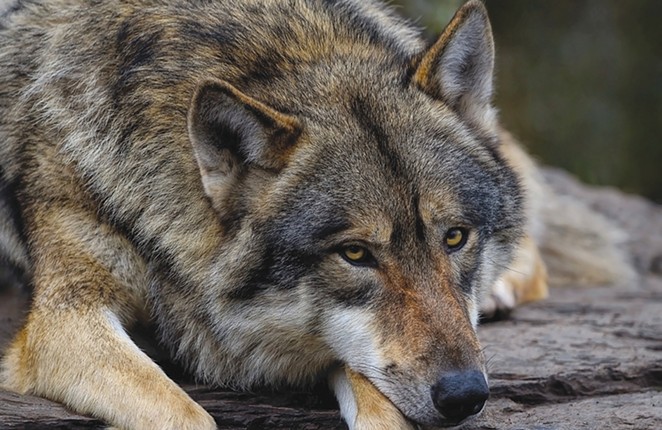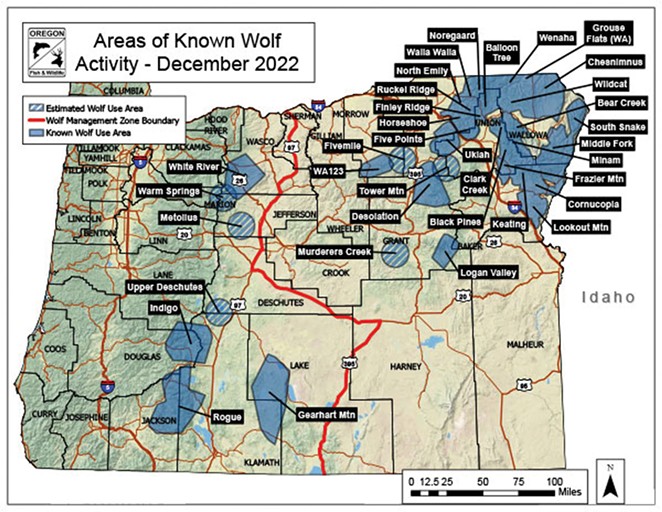Deschutes County took a first step toward wolf reimbursements, two years after grey wolves settled in the county. The Wolf Depredation Compensation and Financial Assistance Committee met for the first time on June 26 to establish rules of the committee that is tasked with establishing reimbursement for farm animals and direct grants for wolf-prevention strategies.
Farmers and ranchers are eligible for compensation under House Bill 3560, a 2011 bill directing the Oregon Department of Agriculture to dole out grant money for ranchers impacted by a returning population of wolves. Before Europeans settled in Oregon, wolves were common across the state but had been deliberately eradicated by the 1940s after a 100-year span where people could collect bounties on killed wolves.

A wolf wasn't spotted in Oregon again until 1999, and now the Oregon Department of Fish and Wildlife estimated a minimum population was 178 at the end of 2022, spread among 26 packs ranging from two to 12 members. There are two packs of wolves that cross into Deschutes County; the Upper Deschutes pack with territory in both Deschutes and Klamath County and the Metolius Pack that mostly resides in Jefferson County but does cross into the north end of Deschutes County.
ODFW Wolf Biologist Aaron Bott said they've only confirmed one animal death from wolves in Deschutes County, but some ranchers have claimed other wolf kills occurred. Wolves returning to Deschutes County allowed it to establish a committee, which is comprised of two representatives from the ranching community, two conservationists and Deschutes County Commissioner Phil Chang. Two members from local businesses will be appointed at a later meeting.
"Now that there's confirmed depredations [wolf killings], there's huge interest from the ranching community," Chang said. "It is a great thing that we will have this committee in place in order to process compensation applications in January 2024."
Money is distributed each January for depredations of livestock, and grants are distributed for ranchers to upgrades. Bott said the best preventative measures are removing attractants like open bone pits of dead animals, more herders keeping an eye out on flocks and herds, protection dogs, husbandry adjustments to make tougher cattle, alarm systems or fencing. Prevention is about 30% of the money allocated in wolf depredation programs. All could be partially reimbursed by the county, but how much it will pay will depend on what the committee decides.
"It's county-by-county-based discretion on how much, for example, a producer is reimbursed for their livestock, or how much the county will reimburse someone for the purchase of a dog. In some counties, it's $200 for a dog and others it's $2,000 per dog," Bott said.

Money could be kicked back by January, and some are already working on prevention. Ahsanti Samuels, a rancher in Terrebonne, owns the one calf that ODFW confirmed as a legitimate depredation. He grazes cattle across Deschutes, Jefferson and Wasco counties.
"I'm the lucky guy with the wolves on both of my territories," Samuels told the committee. "We did have one calf kill, but I've seen a lot of attempts where they weren't successful."
Samuels said he's invested about $25,000 in different prevention strategies like electric fencing, more supervision and flandry — which is the process of tying ropes to fencing which can confuse and deter wolves from entering a fence line for several months. It's also changed how he looks at husbandry, and said he's more likely to breed tougher, more protective cows.
Determining a legitimate depredation is tricky, though. In 2017, a Baker County rancher claimed he lost dozens of calves and cows, despite there not being a confirmed wolf-killed-farm animal since 2012, according to OPB. ODFW investigates all depredations through scarring, internal bruising and determines if it's a confirmed, probable, possible or unlikely wolf kill.
"Wolves are scavengers, if they can live off of scavenging, and never go hunting, they would. They're not great hunters. They're persistent hunters. If they can get a free hamburger, it's laying on the side of the road, they will eat that over chasing an 800-pound elk," Bott said. "So, we have to find out if wolves ate on the carcass or if they kill the livestock."
There will likely be more wolves settling in the area in the future. There've been other sightings, but often its misidentified coyotes or migrating wolves rather than a group establishing territory.
"With two wolves in the landscape in very favorable habitat, we can expect more wolves to come in in the future. If nothing else, these guys will reproduce and we should see more wolves," Bott said. "For the time being we have detected two wolves that are currently in this area, that will change even as soon as tomorrow, but possibly not for two years or three years."
The wolf committee didn't schedule its next meeting, but its goal is to get plans for applications in place by the January deadline.
























